trailer Citroen C3 RHD 2015 2.G Owner's Manual
[x] Cancel search | Manufacturer: CITROEN, Model Year: 2015, Model line: C3 RHD, Model: Citroen C3 RHD 2015 2.GPages: 324, PDF Size: 9.86 MB
Page 5 of 324
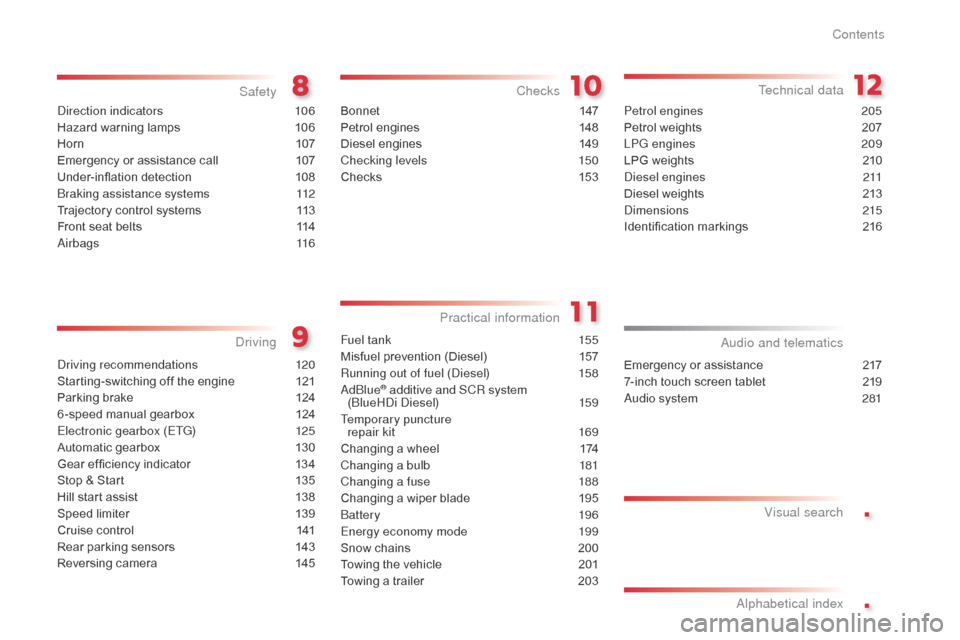
.
.
direction indicators 106
Hazard warning lamps
1
06
Horn
10
7
Emergency or assistance call
1
07
Under-inflation detection
1
08
br
aking assistance systems
1
12
Trajectory control systems
1
13
Front seat belts
1
14
air
bags
116
Safety
driving recommendations 1 20
Starting-switching off the engine
1
21
Parking brake
1
24
6 -speed manual gearbox
1
24
Electronic gearbox (ETG)
1
25
Automatic gearbox
1
30
Gear ef ficiency indicator
1
34
Stop & Start
1
35
Hill start assist
1
38
Speed limiter
1
39
Cruise control
1
41
Rear parking sensors
1
43
Reversing camera
1
45
driving
Emergency or assistance 2 17
7-inch touch screen tablet
2
19
au
dio system
2
81
audio and telematics
al
phabetical index
Bonnet 14 7
Petrol engines
1
48
Diesel engines
1
49
Checking levels
1
50
Checks
15
3
Checks
Fuel tank 155
Misfuel prevention (Diesel)
1
57
Running out of fuel (
di
esel)
1
58
a
d
blu
e
® additive and SCR system
(bl
ueHdi di esel) 1 59
Temporary puncture repair kit
1
69
Changing a wheel
1
74
Changing a bulb
1
81
Changing a fuse
1
88
Changing a wiper blade
1
95
bat
tery
196
Energy economy mode
1
99
Snow chains
2
00
Towing the vehicle
2
01
Towing a trailer
2
03
Practical information Technical data
Petrol engines 2
05
Petrol weights
2
07
LPG engines
2
09
LPG weights
2
10
di
esel engines
2
11
Diesel weights
2
13
di
mensions
215
Identification markings
2
16
Visual search
Contents
Page 11 of 324
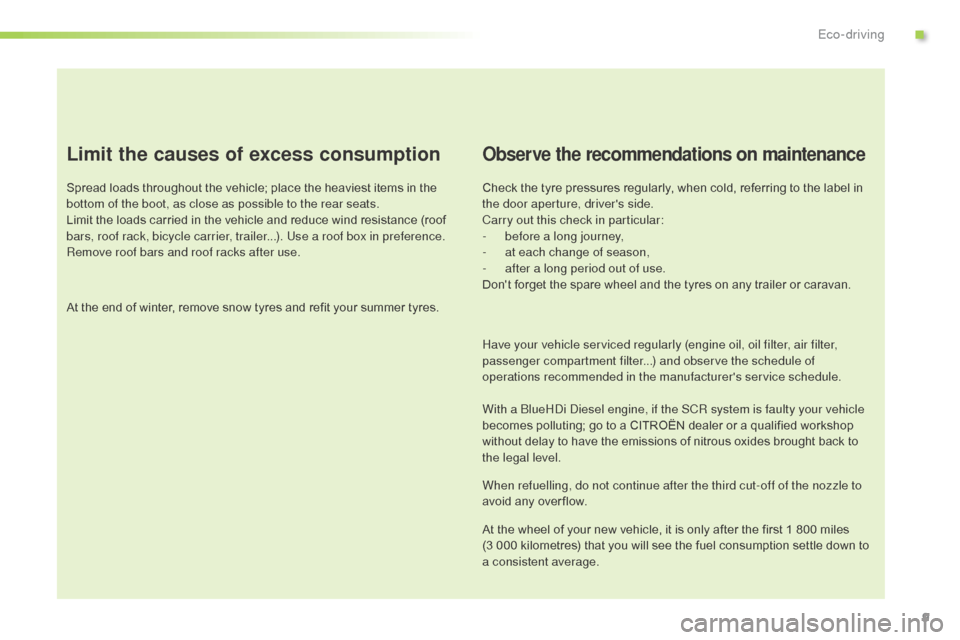
9
Limit the causes of excess consumption
Spread loads throughout the vehicle; place the heaviest items in the
bottom of the boot, as close as possible to the rear seats.
Limit the loads carried in the vehicle and reduce wind resistance (roof
bars, roof rack, bicycle carrier, trailer...). Use a roof box in preference.
Remove roof bars and roof racks after use.
At the end of winter, remove snow tyres and refit your summer tyres.
Observe the recommendations on maintenance
Check the tyre pressures regularly, when cold, referring to the label in
the door aperture, driver's side.
Carry out this check in particular:
-
b
efore a long journey,
-
a
t each change of season,
-
a
fter a long period out of use.
Don't forget the spare wheel and the tyres on any trailer or caravan.
Have your vehicle serviced regularly (engine oil, oil filter, air filter,
passenger compartment filter...) and observe the schedule of
operations recommended in the manufacturer's service schedule.
With a
b
l
ueH
di
d
i
esel engine, if the SCR system is faulty your vehicle
becomes polluting; go to a CITROËN dealer or a qualified workshop
without delay to have the emissions of nitrous oxides brought back to
the legal level.
When refuelling, do not continue after the third cut-off of the nozzle to
avoid any over flow.
At the wheel of your new vehicle, it is only after the first 1 800 miles
(3
000 kilometres) that you will see the fuel consumption settle down to
a consistent average.
Eco-driving
.
Page 146 of 324

144
You can activate or deactivate the system by
means of the multifunction screen configuration
menu. The system state is memorised when
switching off the ignition.
For more information on access to the parking
sensors menu, refer to " Vehicle configuration"
or " Vehicle parameters" section for your
multifunction screen.
Operating faults
If there is an operating fault, when
reverse gear is engaged this
warning lamp comes on in the
instrument panel, accompanied by
an audible signal (short beep) and a
message in the multifunction screen.
Programming
The system will be deactivated
automatically when towing a trailer or
when a bicycle carrier is fitted (vehicle
fitted with a towbar or bicycle carrier
recommended by CITR
oËn)
.In bad or wintry weather, ensure that
the sensors are not covered with mud,
frost or snow.
driving
Page 191 of 324
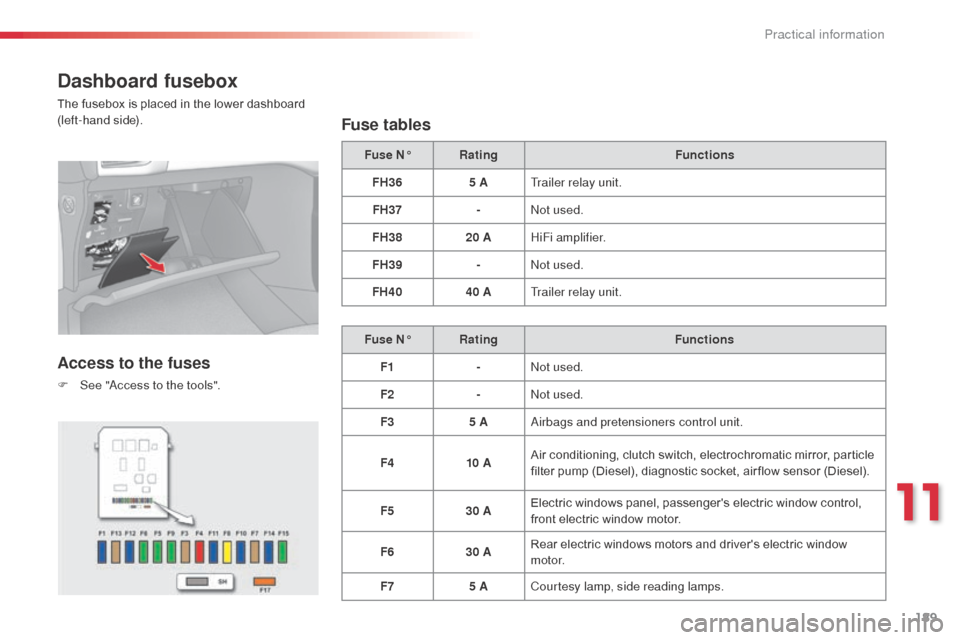
189
Dashboard fusebox
The fusebox is placed in the lower dashboard
(left-hand side).
Access to the fuses
F See "access to the tools".
Fuse tables
Fuse N° Rating Functions
FH36 5 ATrailer relay unit.
FH37 -
no
t used.
FH38 20 AHiFi amplifier.
FH39 -
no
t used.
FH40 40 ATrailer relay unit.
Fuse N° Rating Functions
F1 -
no
t used.
F2 -
no
t used.
F3 5 A
ai
rbags and pretensioners control unit.
F4 10 AAir conditioning, clutch switch, electrochromatic mirror, particle
filter pump (Diesel), diagnostic socket, air flow sensor (Diesel).
F5 30 AElectric windows panel, passenger's electric window control,
front electric window motor.
F6 30 ARear electric windows motors and driver's electric window
motor.
F7 5 ACourtesy lamp, side reading lamps.
11
Practical information
Page 192 of 324
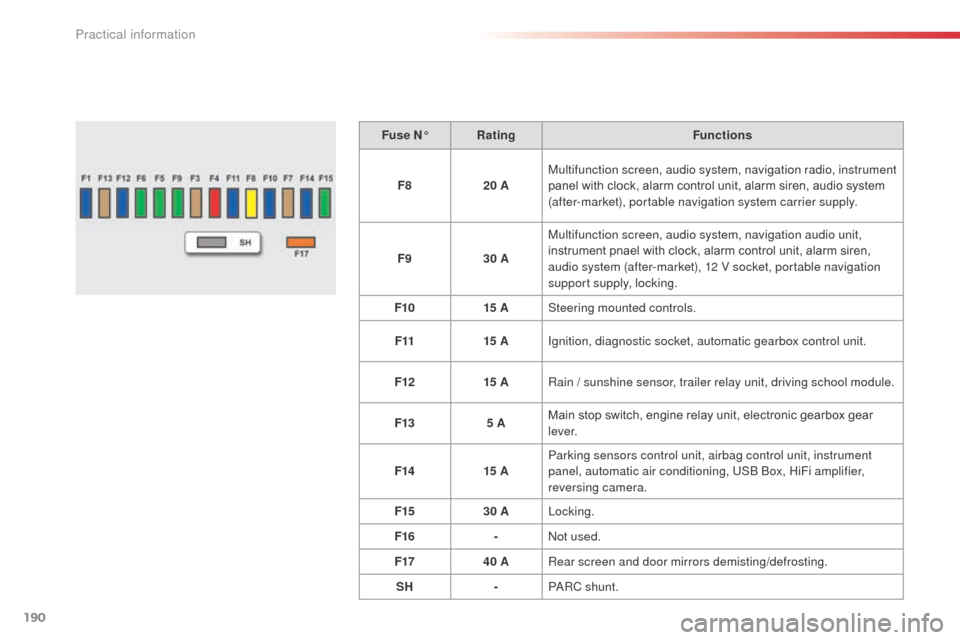
190
Fuse N°Rating Functions
F8 20 AMultifunction screen, audio system, navigation radio, instrument
panel with clock, alarm control unit, alarm siren, audio system
(after-market), portable navigation system carrier supply.
F9 30 AMultifunction screen, audio system, navigation audio unit,
instrument pnael with clock, alarm control unit, alarm siren,
audio system (after-market), 12 V socket, portable navigation
support supply, locking.
F10 15 ASteering mounted controls.
F11 15 AIgnition, diagnostic socket, automatic gearbox control unit.
F12 15 ARain / sunshine sensor, trailer relay unit, driving school module.
F13 5 AMain stop switch, engine relay unit, electronic gearbox gear
l eve r.
F14 15 AParking sensors control unit, airbag control unit, instrument
panel, automatic air conditioning, US
b
b
o
x, HiFi amplifier,
reversing camera.
F15 30 ALocking.
F16 -
no
t used.
F17 40 ARear screen and door mirrors demisting/defrosting.
SH -P
aR
C shunt.
Practical information
Page 205 of 324

203
Towing a trailer
Distribution of loads
F distribute the load in the trailer so that the heaviest items are as close as possible to
the axle and the nose weight approaches the
maximum permitted without exceeding it.
Air density decreases with altitude, thus
reducing engine performance.
a
b
ove
1
000 metres, the maximum towed load must
be reduced by 10
% for every 1 000 metres of
altitude.
Your vehicle is primarily designed for
transporting people and luggage, but it may
also be used for towing a trailer.
Refer to the "Technical data" section for details
of the weights and towed loads which apply to
your vehicle.
We recommend the use of genuine
CITROËN towbars and their harnesses
that have been tested and approved
from the design stage of your vehicle,
and that the fitting of the towbar is
entrusted to a CITR
oËn
dealer or a
qualified workshop.
If the towbar is not fitted by a
CITR
oËn
dealer, it must still be
fitted in accordance with the vehicle
manufacturer's instructions.
Driving advice
Driving with a trailer places greater demands
on the towing vehicle and the driver must take
particular care.
Side wind
F Take into account the increased sensitivity to side wind.
11
Practical information
Page 206 of 324
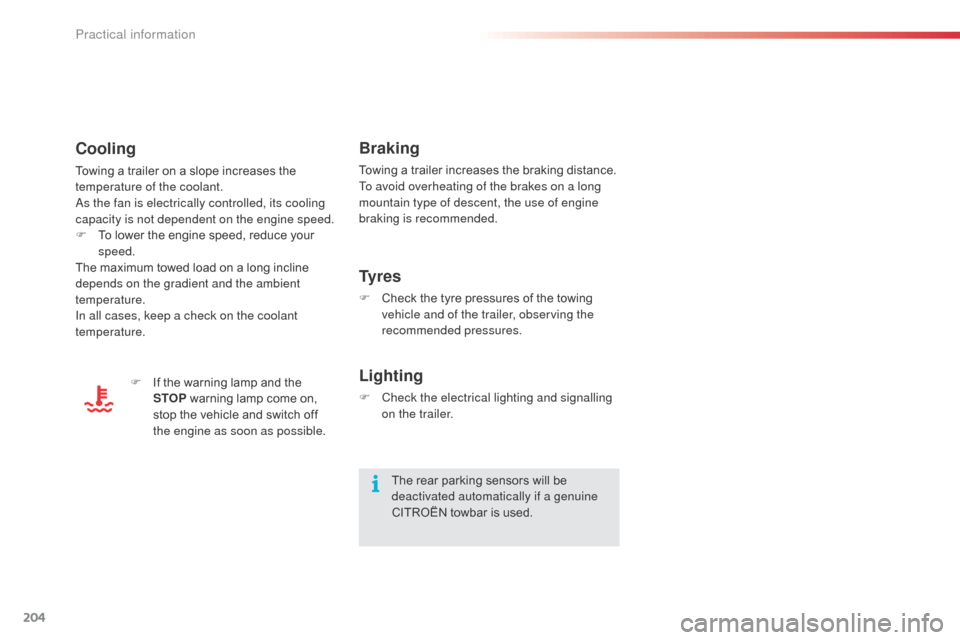
204
Braking
Towing a trailer increases the braking distance.
To avoid overheating of the brakes on a long
mountain type of descent, the use of engine
braking is recommended.
Ty r e s
F Check the tyre pressures of the towing vehicle and of the trailer, observing the
recommended pressures.
Lighting
F Check the electrical lighting and signalling on the trailer.
The rear parking sensors will be
deactivated automatically if a genuine
CITROËN towbar is used.
Cooling
Towing a trailer on a slope increases the
temperature of the coolant.
as t
he fan is electrically controlled, its cooling
capacity is not dependent on the engine speed.
F
T
o lower the engine speed, reduce your
speed.
The maximum towed load on a long incline
depends on the gradient and the ambient
temperature.
In all cases, keep a check on the coolant
temperature.
F
I
f the warning lamp and the
STOP warning lamp come on,
stop the vehicle and switch off
the engine as soon as possible.
Practical information
Page 209 of 324
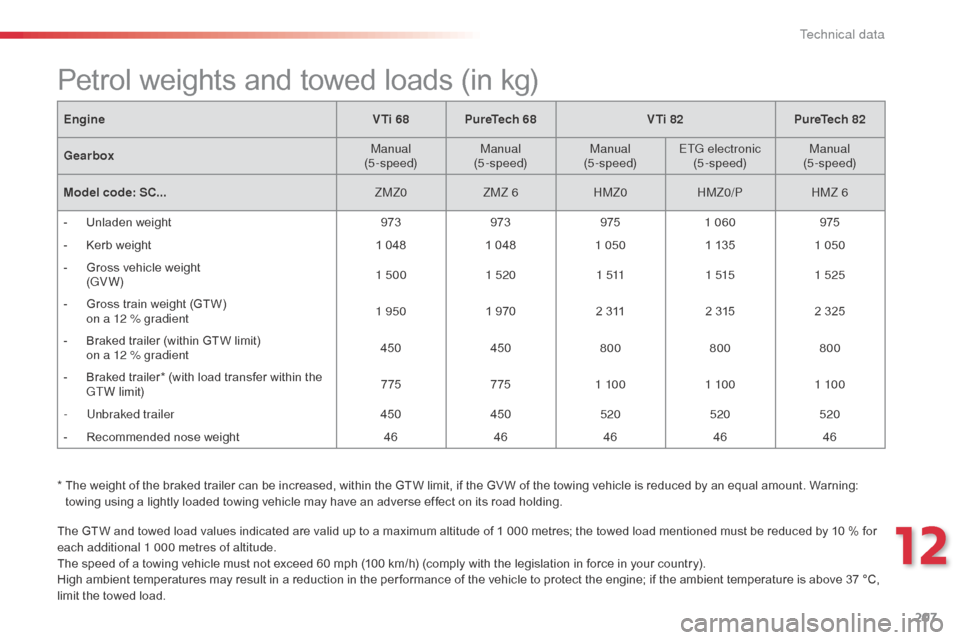
207
The GTW and towed load values indicated are valid up to a maximum altitude of 1 000 metres; the towed load mentioned must be reduced by 10 % for
each additional 1 000 metres of altitude.
The speed of a towing vehicle must not exceed 60 mph (100 km/h) (comply with the legislation in force in your country).
High ambient temperatures may result in a reduction in the per formance of the vehicle to protect the engine; if the ambient temperature is above 37 °C,
limit the towed load.
Petrol weights and towed loads (in kg)
EngineVTi 68PureTech 68 VTi 82PureTech 82
Gearbox Manual
(5-speed) Manual
(5-speed) Manual
(5-speed) ETG electronic
(5-speed) Manual
(5-speed)
Model code: SC... ZMZ0ZMZ 6 HMZ0HMZ0/P HMZ 6
-
U
nladen weight 973973 9751 060 975
-
K
erb weight 1 0481 048 1 050 1 1351 050
-
G
ross vehicle weight
(GV W) 1 500
1 520 1 5111 5151 525
-
G
ross train weight (GTW)
o
n a 12 % gradient 1 950
1 970 2 3112 3152 325
-
B
raked trailer (within GTW limit)
o
n a 12 % gradient 450
450800 800800
-
B
raked trailer* (with load transfer within the
GTW limit) 775
7751 10 0 1 10 01 10 0
-
U
nbraked trailer 450450 520520520
-
R
ecommended nose weight 4646464646
*
T
he weight of the braked trailer can be increased, within the GTW limit, if the GV W of the towing vehicle is reduced by an equal amount. Warning:
towing using a lightly loaded towing vehicle may have an adverse effect on its road holding.
12
Technical data
Page 210 of 324
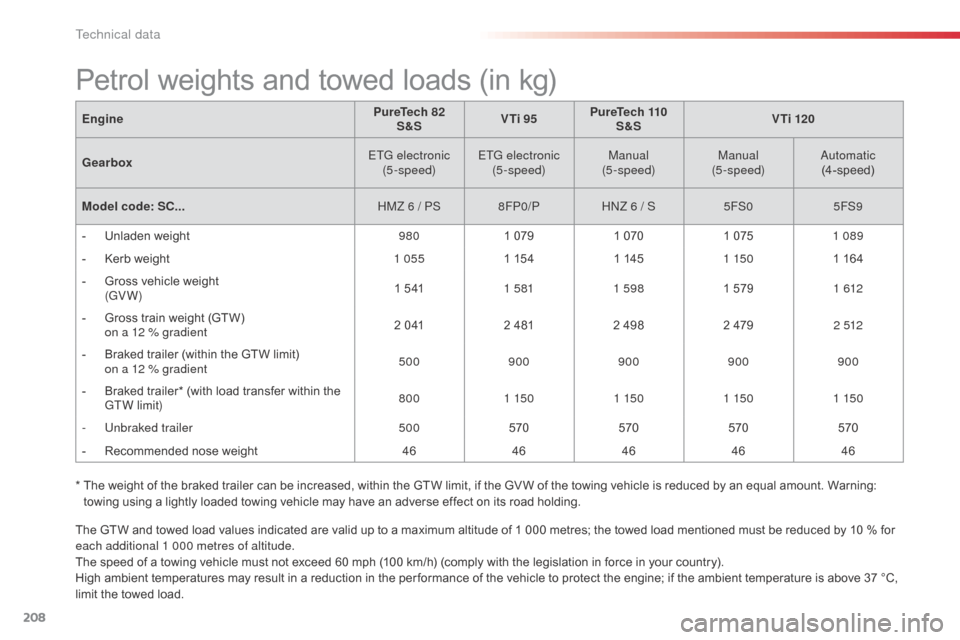
208
The GTW and towed load values indicated are valid up to a maximum altitude of 1 000 metres; the towed load mentioned must be reduced by 10 % for
each additional 1 000 metres of altitude.
The speed of a towing vehicle must not exceed 60 mph (100 km/h) (comply with the legislation in force in your country).
High ambient temperatures may result in a reduction in the per formance of the vehicle to protect the engine; if the ambient temperature is above 37 °C,
limit the towed load.
Petrol weights and towed loads (in kg)
EnginePureTech 82
S&S VTi 95PureTech 110
S&S V Ti 120
Gearbox ETG electronic
(5-speed) ETG electronic
(5-speed) Manual
(5-speed) Manual
(5-speed)
a
utomatic
(4-speed)
Model code: SC... HMZ 6 / PS8FP0/PH
nZ 6 / S 5
FS05FS9
-
U
nladen weight 9801 079 1 0701 0751 089
-
K
erb weight 1 0551 1541 1451 1501 164
-
G
ross vehicle weight
(GV W) 1 541
1 5811 598 1 579 1 612
-
G
ross train weight (GTW)
o
n a 12 % gradient 2 041
2 4812 498 2 4792 512
-
B
raked trailer (within the GTW limit)
o
n a 12 % gradient 500
900 900900900
-
B
raked trailer* (with load transfer within the
GTW limit) 800
1 150 1 1501 1501 150
-
U
nbraked trailer 500570570570570
-
R
ecommended nose weight 4646464646
*
T
he weight of the braked trailer can be increased, within the GTW limit, if the GV W of the towing vehicle is reduced by an equal amount. Warning:
towing using a lightly loaded towing vehicle may have an adverse effect on its road holding.
Technical data
Page 212 of 324
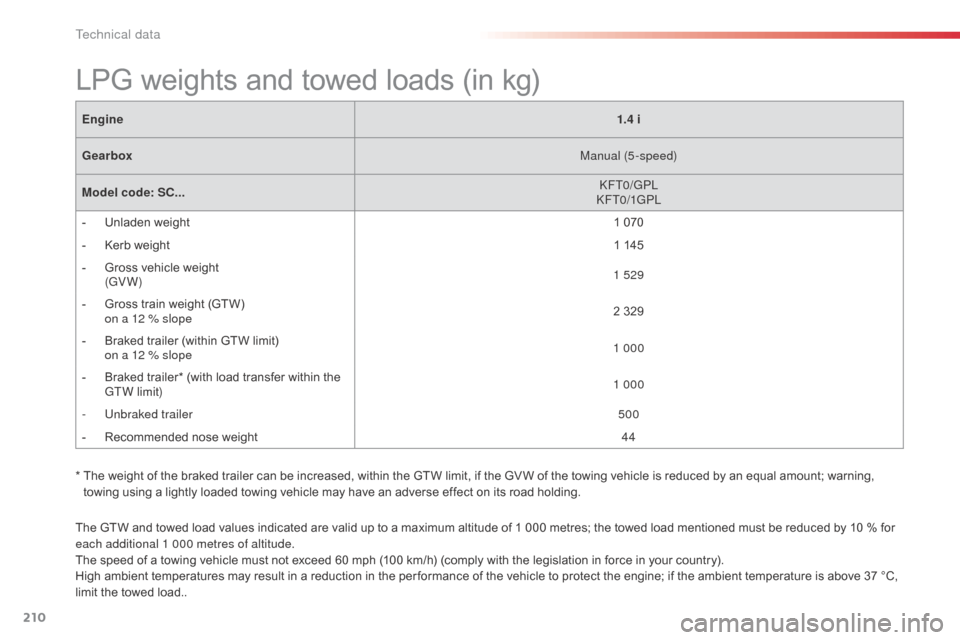
210
The GTW and towed load values indicated are valid up to a maximum altitude of 1 000 metres; the towed load mentioned must be reduced by 10 % for
each additional 1 000 metres of altitude.
The speed of a towing vehicle must not exceed 60 mph (100 km/h) (comply with the legislation in force in your country).
High ambient temperatures may result in a reduction in the per formance of the vehicle to protect the engine; if the ambient temperature is above 37 °C,
limit the towed load..
LPG weights and towed loads (in kg)
Engine1.4 i
Gearbox Manual (5-speed)
Model code: SC...
kF
T0/GPL
kF
T0/1GPL
-
U
nladen weight 1 070
-
K
erb weight 1 145
-
G
ross vehicle weight
(GV W) 1 529
-
G
ross train weight (GTW)
o
n a 12 % slope 2 329
-
B
raked trailer (within GTW limit)
o
n a 12 % slope 1 000
-
B
raked trailer* (with load transfer within the
GTW limit) 1 000
-
U
nbraked trailer 500
-
R
ecommended nose weight 44
*
T
he weight of the braked trailer can be increased, within the GTW limit, if the GV W of the towing vehicle is reduced by an equal amount; warning,
towing using a lightly loaded towing vehicle may have an adverse effect on its road holding.
Technical data